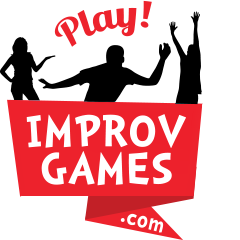Quick Description
Early in an improvised scene, a director (host or other player) stops the scene, backs it up, and asks the players to make a ‘different choice’. After this is repeated 3 times, the audience is asked which of the three choices they want to see played out. It’s as if there is a fork in the road and the audience chooses the path.
How to Play
Players start a scene and a director stops the scene after approximately 15 to 30 seconds or after a choice has been made. The players are asked to back the scene up a little bit and take the scene in a different direction (a second choice). The players are stopped again and asked to rewind and take the scene in yet another direction.
The third scene is stopped, and now the director (or emcee, or another player) asks the audience which direction (fork) they would like the scene to follow. The director chooses the direction that received the most enthusiastic response.
Have the players continue the scene in this direction.
Variations
The scene can be stopped and this process repeated as many times as you like.
You could pick one person from the audience and ask them which direction they want the scene to go.
There could be additional prompts solicited by the audience. For example:
- Should this next choice be safer or more dangerous?
- Should the next choice be more openly dramatic or hidden dramatic?
- Should the next choice be affectionate or aggressive?
Notes
Fork in the Road is based on the theory that the audience knows which is the best direction to take the story. In contrast to an individual who may want to shout clever things and make the players do odd or stupid things.
I’ve used this game as an opener for corporate performances. It lets them see that the work can go in any direction and lets them have a voice.
I haven’t played it with the prompts listed above. So … let me know what you find out.
Yes, this game is similar in style to the game New Choice.
Origins
I created this game many years ago as a demonstration of improvisation for corporate shows. It’s quite possible that someone else also developed it. My company (Fratelli Bologna) used it for corporate improv show to demonstrate how easily a story can shift direction. We also used it to demonstrate that as a group, the audience knows which path the story needs to take to be interesting.
Get The Playbook so you have hundreds of games in your pocket when you need them.
[Thanks to Kurt Bodden for his editing and insights.]
Have a game you want written up? Let me know.
